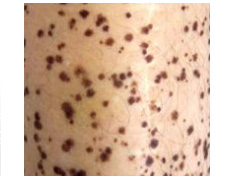







Multiple lentigines on the leg of patient with LEOPARD syndrome
LEOPARD syndrome is a condition that affects many areas of the body. The acronym LEOPARD describes the characteristic features associated with the condition: lentigines (brown skin spots similar to freckles), ECG abnormalities (measurement of abnormal electrical heart activity), ocular hypertelorism (widely spaced eyes), pulmonary stenosis (narrowing of the artery from the heart to the lungs), abnormalities of genitalia (reproductive organs), retardation of growth (short stature), and deafness. These features vary, however, even among affected individuals in the same family. Not all individuals affected with LEOPARD syndrome have all the characteristic features of this condition.
The lentigines seen in LEOPARD syndrome typically first appear in mid-childhood, mostly on the face, neck, and upper body. Affected individuals may have thousands of lentigines by the time they reach puberty. Unlike freckles, the appearance of lentigines has nothing to do with sun exposure.
In addition to lentigines, people with LEOPARD syndrome may have lighter brown skin spots called café-au-lait spots. Café-au-lait spots tend to develop before the lentigines, appearing within the first year of life in most affected people.
Many of the signs and symptoms of LEOPARD syndrome also occur in a similar disorder called Noonan syndrome. It can be difficult to tell the two disorders apart in early childhood. However, the features of the two disorders differ later in life.
LEOPARD syndrome is thought to be a rare condition; approximately 200 cases have been reported worldwide. This condition is inherited in an autosomal dominant pattern, which means one copy of the altered gene in each cell is sufficient to cause the disorder. In some cases, an affected person inherits the mutation from one affected parent. Other cases result from new mutations in the gene and occur in people with no history of the disorder in their family.
Mutations in the PTPN11, RAF1, or BRAF genes cause LEOPARD syndrome. Approximately 90 percent of individuals with LEOPARD syndrome have mutations in the PTPN11 gene. RAF1 and BRAF gene mutations are responsible for a total of about 10 percent of cases. A small proportion of people with LEOPARD syndrome do not have an identified mutation in any of these three genes. In these individuals, the cause of the condition is unknown.
The PTPN11, RAF1, and BRAF genes all provide instructions for making proteins that are involved in important signaling pathways needed for the proper formation of several types of tissue during development. These proteins also play roles in the regulation of cell division, cell movement, and cell differentiation (the process by which cells mature to carry out specific functions). Mutations in the PTPN11, RAF1, or BRAF genes lead to the production of a protein that functions abnormally. This abnormal functioning impairs the protein's ability to respond to cell signals. A disruption in the regulation of systems that control cell growth and division leads to the characteristic features of LEOPARD syndrome.
>
>
>
>
>
>
>
>
>
>
>
>
>
>
>
>
>
>
>
>
>
>
>
>
>
>
INTRODUCTION
PIGMENTARY DISORDER TYPES
Disorders of
Hyperpigmentation
Disorders of Hypopigmentation
COMMON PIGMENTARY DISORDERS
Age Spots/Liver Spots/Lentigos
Acanthosis Nigricans
Albinism
Cafe-au-Lait Macules
Ephelides (Freckles)
Erythema Dyschromicum Perstans (Ashy Dermatosis)
Familial Racial Periorbital Hyperpigmentation
Idiopathic Guttate Hypomelanosis
Leopard Syndrome
Linea Nigra
Melanoma
Melasma
Nevus (birthmarks/moles)
Parkinsons Disease
Phytophotodermatits
Pityriasis Alba
Poikiloderma of Civatte
Postinflammatory
Hyperpigmentation & Hypopigmantation
Seborrheic Keratoses
Sturge-Weber Syndrome
Substance Induced
Hypermelanosis
Tinea Nigra/Tinea Versicolor/Pityriasis
Versicolor
Vitiligo
Waardenburg Syndrome

<< Previous: Idiopathic Guttate Hypomelanosis
Next: Linea Nigra >>